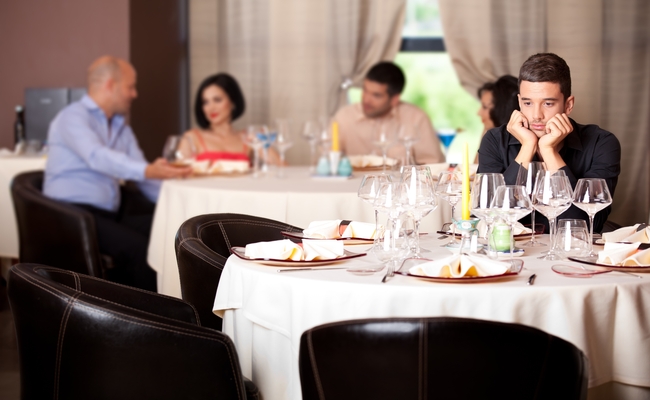
According to a study conducted by the Hyundai Research Institute, the no-show epidemic is sizable, with a minimum of 10 percent of all reservations in five major service sectors no-showing in 2015. (Image: Korea Bizwire)
SEOUL, Oct. 24 (Korea Bizwire) – On October 15, a social media post by a restaurant owner criticizing a company for no-showing on a dinner reservation for 400 went viral, stirring up indignation from the Korean online community for what the owner described was the third time the same company had committed the faux pas.
The identity of the guilty party was later revealed to be a group from construction company Lotte E&C, which eventually released a statement after the situation was reported on by multiple media outlets.
The company’s statement corrected the social media post, pointing out that “the reservation was for 300 and not 400” and that it had informed the restaurant that there was a possibility the group may be unable to attend. It further explained that the dinner was meant to celebrate the signing of a construction contract, which became meaningless when competitor GS E&C beat them out for the job.

The identity of the guilty party was later revealed to be a group from construction company Lotte E&C, which eventually released a statement after the situation was reported on by multiple media outlets. (Image: Social Media outlet)
The public disclosure of the background story did little to appease the public and indeed the restaurant owner, who eventually received a 400,000 won payment on top of the initial 600,000 won reservation deposit. What the public relations hiccup did accomplish, however, was to draw attention to the rampant “no-show” culture across virtually all service industries in the country.
According to a study conducted by the Hyundai Research Institute, the no-show epidemic is sizable, with a minimum of 10 percent of all reservations in five major service sectors no-showing in 2015. Restaurants topped the chart at 20 percent, followed by hospitals, hair salons, express bus services, and small musical performances.
The incurred costs to the five sectors were estimated at 4.5 trillion won in lost revenue as well as 108,000 potential jobs.

For instance, outpatient appointments at 14 national university hospitals had an average no-show rate exceeding 13 percent this July and August, per the Education, Culture, Sports and Tourism Committee of the National Assembly. (Image: FTC official blog)
Consequently, efforts have been made in recent years to combat the trend. In 2015, a number of famous chefs launched a media campaign titled ‘No show, no chef’ to raise awareness of the issue. This was followed up by another initiative the next year by the Fair Trade Commission, as general society and government agencies alike began to take the prevalence of no-show consumer culture more seriously.
These measures, though they may have had limited success in lowering the frequency of no-shows, have been unable to make a significant impact on the spread of the culture. For instance, outpatient appointments at 14 national university hospitals had an average no-show rate exceeding 13 percent this July and August, per the Education, Culture, Sports and Tourism Committee of the National Assembly.
On October 17, the same government subcommittee also disclosed the details of a report from the Culture Heritage Administration, which stated that 3 out of 10 reserved ticket holders for the limited offer nighttime tours of Gyeongbokgung (23.7 percent) and Changdeokgung Palaces (38.0 percent) were no-shows.

What the public relations hiccup did accomplish, however, was to draw attention to the rampant “no-show” culture across virtually all service industries in the country. (Image: Social Media outlet)
Titled ‘Moonlight Tour’, the event is popular and the purchasing process highly competitive, normally selling out rapidly. As such, the large number of no-shows not only does a disservice to the organizers of the event, but disadvantages others more willing to attend.
The report stated in addition that the rate of no-shows had increased by nearly 10 percent for both palaces since 2015, another statistic indicating that the culture is not only alive, but thriving.
Establishments are no longer taking this treatment lying down; thanks to the ubiquity of smartphones and smartphone apps, they are taking matters into their own hands by requiring deposits or even a full pre-meal payment before approving a reservation.

On October 17, the same government subcommittee also disclosed the details of a report from the Culture Heritage Administration, which stated that 3 out of 10 reserved ticket holders for the limited offer nighttime tours of Gyeongbokgung (23.7 percent) and Changdeokgung Palaces (38.0 percent) were no-shows. (Image: Yonhap)
An app named ‘Daily Hotel’ rolled out a ‘Daily Gourmet’ feature, which allows customers to make reservations, choose their desired menu selections, and pay the full meal price upfront, resulting in a reported less than 1 percent no-show rate for the restaurants.
Similar apps for booking appointments and reservations, TTokTak for hospitals and Kakao Hair Shop for hair salons, have also been introduced, though the stipulations governing their use are less stringent than with Daily Hotel (Kakao Hair levies a fine of 10 percent of the expected charge).
Unfortunately, the service industry may always be limited to the extent in which it can regulate customer behavior. On October 23, celebrity chef Choi Hyeon-seok made an appearance on Kim Hyun-jung’s News Show on CBS Radio, where he explained the difficulties “no-show folk” cause restaurants.

In 2015, a number of famous chefs launched a media campaign titled ‘No show, no chef’ to raise awareness of the issue. (Image: No Show No Chef campaign video segment)
Choi, who partook in the 2015 ‘No show, no chef’ campaign, pointed out the harsh reality faced by restaurants when prompted with a suggestion to demand cancellation fees from no-shows. “Honestly, the customer is king and we are in a lesser position. For the situationally weaker to confront the stronger and insist ‘Please have a little respect for the rules’ is not easy. If, customers are offended, they can always go somewhere else,” he said.
The only real hope for the service sector may be for Korean consumers to fully accept what Choi reminded everyone during his radio interview, that “reservations are absolutely the same thing as promises”.
S.B.W. (sbw266@koreabizwire.com)






